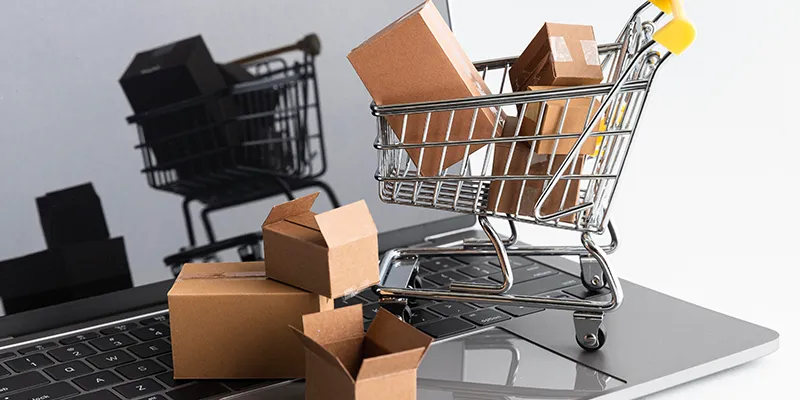How to start an online fashion business with Rs 10,000 initial investment
With India’s online fashion industry picking up steam since the onset of the coronavirus pandemic in 2020, the time is ripe for starting online fashion businesses. Here's how you can start online fashion business with investment as low as Rs 10,000.
The closure of offline retail stores during India’s coronavirus-induced lockdowns meant there was only one winner - ecommerce.
Even as the retail market shrunk by five percent due to the impact of the COVID-19 pandemic, the Indian ecommerce industry grew by 25 percent in 2020-21, according to a Bain & Company and report titled How India Shops Online 2021.
And amidst the coronavirus crisis that toppled many industries, India’s fashion industry continued to grow.
Ecommerce focused supply-chain SaaS platform revealed in a report that this industry continues to grow with order volume growth of 51 percent and GMV (Gross Merchant Value) growth of 45 percent in FY21, compared to the previous FY.
The time is now seemingly right for India’s budding entrepreneurs to consider starting online fashion businesses and tapping into this opportunity.
Following a do-it-yourself (DIY) and asset-light retail model of dropshipping, one can start a fashion ecommerce business for potentially as low as Rs 10,000.
One can also opt for an inventory-based model with initial investment of upwards of Rs 1 lakh (this topic will be explained in detail in future articles).

Here’s how the dropshipping model works:
Dropshipping explained
Dropshipping is a form of retail where one can accept online orders on behalf of a product manufacturer and transfer the order and shipment details to the manufacturer and/or logistics partners.
In this ecommerce model, one does not keep any fashion goods in stock, and hence does not need to spend on purchasing apparel or renting a warehouse to store them.
Basic first steps
First, the entrepreneur needs to open a current account at a bank of their choice. This step does not involve any cost.
Then, the online fashion business has to be incorporated and a GST certificate has to be obtained. This can be done by the entrepreneurs themselves, but it is easier to hire a consultant who can perform the task for Rs 5,000-Rs 8,000 (inclusive of incorporation fees of around Rs 2,500 for a sole proprietorship).
A trademark can also be obtained for Rs 4,500 for a sole proprietorship ecommerce business. While this can be done by yourself, a consultant can file it for a fee of Rs 2,000-Rs 5,000.
Website building
Branding and marketing are essential for seeing success with a dropshipping model for online fashion. Building a website and gaining traction on social media are crucial to this success.
A freelance designer can create a brand logo for as low as Rs 5,000-Rs 6,000, but this step can be taken care of by the entrepreneurs themselves on free design software.
To build the website for the online fashion business, one can leverage platforms like , which charges around $29 (around Rs 2,100) per month.
According to Ayush Agarwal, Founder of online sustainable textiles brand Mush, a platform like Dukaan can create an online store for as low as Rs 8,000 per year. He adds that a freelance web designer can also create a website starting from Rs 15,000.

Mush founders Ayush Agarwal (left) and Nihar Gosalia (right)
Product listing
A budding founder has to also strike a deal with a manufacturer to retail its goods online, and hire a photographer for a product photoshoot. This step can be taken care of in a DIY manner, but hiring a professional photographer can cost anywhere from Rs 100 to Rs 1,000 per SKU.
Then, the products can be listed on the online fashion business’ website.
Payment gateway integrations for the website and striking deals with logistics partners are also required, and usually involve no upfront fee (commissions from sales and/or pre-decided fees based on sales are how most payment gateways and logistics providers prefer to be paid, respectively).
Own website vs Amazon, Flipkart, Myntra
Under the dropshipping model, it is generally not recommended to list products on , , , and other traditional ecommerce websites.
Instead, they believe it is better to sell primarily through a brand’s own website and directly tie up with logistics partners for delivery.
Alok Paul, Co-founder of online women’s apparel brand Berrylush, says, “One drawback is that if delivery is dependent on third party delivery partners, it becomes difficult to control customer experience.”
He adds, “For instance, if you have to ship a product on Amazon in three days, the process is dependent on a third party, and it is not in the entrepreneur’s control if the delivery is delayed or something goes wrong. But such instances could lead to the entrepreneur’s brand getting delisted from an online marketplace.”

Alok Paul, cofounder, Berrylush
Other steps and costs
Packaging can be taken care of at minimal cost, although some entrepreneurs prefer spending on printing their brand logo on packaging.
During the initial stages of a small, fashion ecommerce business, printing of labels and invoices can be taken care of with a basic laser printer. Laptop and internet fees are also considered infrastructure costs, but in many cases, the entrepreneur is likely to own a computer and Wi-Fi connection beforehand.
Marketing
After the supply chain, ecommerce website, and delivery network is functional, entrepreneurs can begin marketing the fashion products on Facebook, Instagram, Google, etc.
Basic knowledge of social media platforms should suffice to promote products online. However, to boost impressions and drive visibility, Facebook marketing is a good place to start, according to Alok.
“A regular manufacturer of fashion apparel does not have the know-how to market its products online. That’s where the dropshipper comes into play and builds brand awareness on social media,” he says, adding:
“For instance, if you have existing potential customers on WhatsApp, you can purchase fashion apparel at wholesale prices and sell to them and scale your business. Meesho is another service which helps small businesses start their ecommerce journey in a simple manner.”
DIY approach for Rs 10,000
If fully outsourced, the steps mentioned above can cost an entrepreneur upwards of Rs 50,000 for a fashion ecommerce business retailing a handful of SKUs.
But Ayush believes most of the costs listed can be cut significantly if the entrepreneurs are willing to learn and perform most of the tasks themselves, and adds that one can begin an online fashion business based on this dropshipping model for Rs 10,000.
“While it is not very easy to build a mechanism for products to be packaged well and delivered on time, dropshipping still remains the cheapest approach to retailing fashion online. There is no procurement, inventory, or warehousing costs involved,” he says.
YourStory’s flagship startup-tech and leadership conference will return virtually for its 13th edition on October 25-30, 2021. Sign up for updates on TechSparks or to express your interest in partnerships and speaker opportunities here.
For more on TechSparks 2021, click here.
Applications are now open for Tech30 2021, a list of 30 most promising tech startups from India. Apply or nominate an early-stage startup to become a Tech30 2021 startup here.
Edited by Megha Reddy










